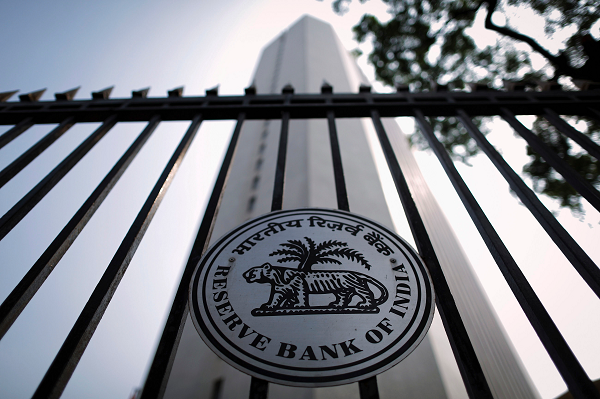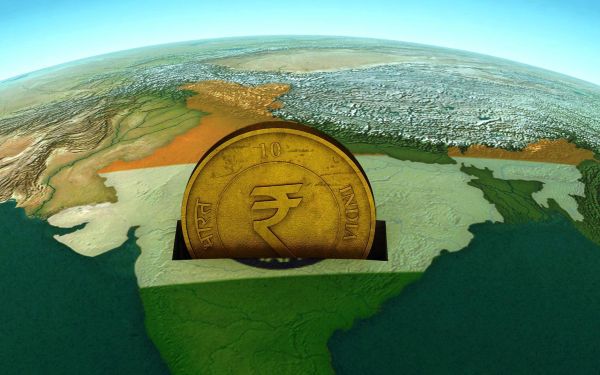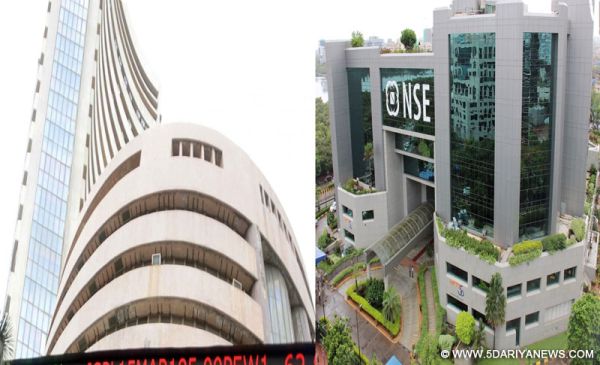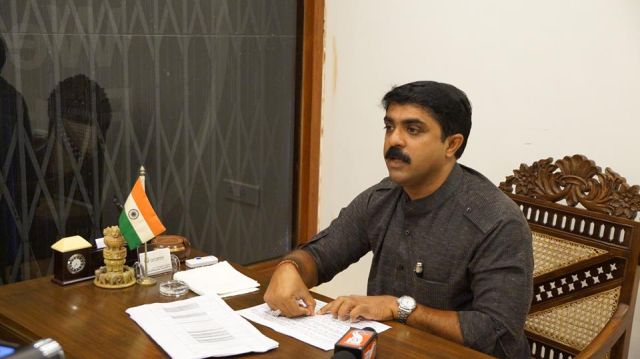
by admin | May 25, 2021 | Banking, Economy, Markets, News
 New Delhi : Continuing rise in food and fuel prices pushed India’s annual retail inflation rate over the five per cent-mark in December, official data showed on Friday, putting paid to hopes of an interest rate cut by the RBI in the near future.
New Delhi : Continuing rise in food and fuel prices pushed India’s annual retail inflation rate over the five per cent-mark in December, official data showed on Friday, putting paid to hopes of an interest rate cut by the RBI in the near future.
According to the data furnished by the Ministry of Statistics and Programme Implementation, December’s consumer price index (CPI) inflation rose to 5.21 per cent from 4.88 per cent in November.
On a year-on-year (YoY) basis, the CPI inflation last month was higher than the 3.41 per cent recorded in December 2016.
The Consumer food price index (CFPI) in December stood at 4.96 per cent compared to the 4.42 per cent of November 2017.
The annual CPI in rural areas in December ruled higher at 5.27 per cent, while in urban India it rose by 5.09 per cent.
Retail inflation on a YoY basis edged higher due to a rise in the prices of food items like vegetables, milk-based products, eggs, meat and fish.
The data showed that vegetables in December became costly by a whopping 29.13 per cent, while prices of milk-based products rose by 4.37 per cent.
Other notable categories such as cereals became dearer by 2.57 per cent and meat and fish recorded a rise of 4.22 per cent.
The sub-category of food and beverages during the month under consideration recorded a rise of 4.85 per cent over the same period last year.
Among non-food categories, the “fuel and light” segment’s inflation rate accelerated to 7.9 per cent in October.
Earlier this month, Finance Minister had told Parliament that the inflation had increased owing to a seasonal rise in vegetable prices and the higher house rent allowances disbursed to government employees under the 7th Pay Commission recommendations.
Inflationary risks forced the Reserve Bank of India (RBI) to hold its key lending rate unchanged for the third time in a succession at 6 per cent in its penultimate bi-monthly monetary policy review of the fiscal last month.
Announcing the decision of the monetary policy committee (MPC), the RBI said inflation is expected to range around 4.3-4.7 per cent in the second half of the fiscal, including the impact of increase in house rent allowance.
The central bank said “two of the key factors determining the cost of living conditions and inflation expectations — food and fuel inflation — edged up in November”.
“The decision of the MPC is consistent with a neutral stance of monetary policy in consonance with the objective of achieving the medium-term target for consumer price index inflation of 4 per cent within a band of +/- 2 per cent, while supporting growth,” an RBI statement said.
—IANS

by admin | May 25, 2021 | Opinions

For representational purpose only
By Amit Kapoor,
One of the fastest-growing economies in the world, India has grown at a rate of above seven per cent over the last decade. Much of this growth can be explained by the growth of its cities. Cities have emerged as economic powerhouses that have defined job growth within the country.
While prosperity has increased in cities, so have the challenges they face. The challenges are of inequality, unplanned urbanisation, mass migration, poverty, unemployment and the like. Some cities have even witnessed a fall in their quality of life.
The challenges that our cities face can be managed if looked at from the lens of competitiveness.
Competitiveness depends on the long-term productivity of a region. A competitive city is a city that successfully facilitates its firms and industries to create jobs, raise productivity, and increase incomes of its citizens over time.
The City Competitiveness Report 2017 represents the competitive performance of 50 Indian cities on different parameters. It uses the framework of Michael Porter’s Diamond Model which defines competitiveness as the sum total of factor conditions, demand conditions, context for firm strategy and rivalry, and related and supporting industries.
Bengaluru has emerged as the most competitive city in India. Mumbai and Pune closely follow. Patna, on the other hand, has emerged as the least competitive city.
The analysis brings out some interesting insights. First, the population of a city has a direct bearing on its level of competitiveness, i.e., big Indian cities are also the most competitive. This suggests that either the population acts as an active resource (as a factor of production) and positively impacts the competitiveness of a city or that competitive cities tend to be more attractive to the general population.
The literacy rates in these cities are substantially higher than India’s national average. This, coupled with their high population densities, creates the best demand conditions in the country, thus adding to their competitiveness levels.
The presence of quality educational institutions in the big cities helps them attract the best talent from all over the country. This, coupled with job opportunities they offer, help them retain such talent. The presence of such diverse talent helps in sustaining the growth, productivity and economy of these cities. Sound financial infrastructure and relatively higher financial literacy levels further add to their competitiveness.
But a large population is not always a boon. It creates challenges pertaining to the movement of people and goods and in the provision of basic services. Governments respond to such problems by improving service delivery and spending on infrastructure. It is not a coincidence that all these cities have operational Metro rail networks and some of the best hospitals and airports in the country. These factors significantly impact the competitiveness of cities.
Secondly, prevailing environmental conditions impact the competitiveness of a city by affecting its labour productivity. While other big cities like Mumbai, Kolkata, Chennai and Hyderabad have managed to retain their competitiveness levels, Delhi has of late witnessed a drop in competitiveness mainly because of its worsening environmental landscape. A similar loss was also witnessed by the neighboring cities of Noida and Gurugram.
Thirdly, the level of industrialisation in a state impacts the competitiveness of its cities. In India, most of the highly competitive cities belong to a small group of industrialised states (including Maharashtra, Tamil Nadu, Gujarat and Karnataka) while the least competitive cities belong to less industrialised states like Jharkhand, Bihar, Chhattisgarh and Jammu and Kashmir, among others. In other words, industrialisation as a policy tool is required to make cities from less industrialised states more competitive.
In the short run, some cities may witness substantial improvements in their competitiveness levels. This may be because of improvement in their factor conditions and demand conditions. But in order to sustain or further improve their competitiveness levels, they must act on the other two pillars of Porter’s Diamond model, i.e., context for strategy and rivalry, and related and supporting industries. It is worth noting that these two pillars are directly related to the level of industrialisation, which cannot be increased overnight.
So, the policymakers in the less industrialised states should look at industrialisation as a long-term solution to make their cities more competitive. Cities in the states of Gujarat, Karnataka, Maharashtra, and Delhi perform well on these pillars. At the city level, old industrial and trade hubs such as Surat, Mumbai, Ahmedabad and Delhi perform well on these pillars.
Lastly, the level of cleanliness and sanitation and competitiveness are positively correlated. Cities in Madhya Pradesh, which have shown exceptional cleanliness performance of late, have seen a rise in their competitiveness levels. Indore was in the news recently for deciding to name and shame people for spitting on roads. Tier 2 and Tier 3 cities like Chandigarh, Vadodara, Coimbatore, Surat, Mysore and Rajkot have witnessed a similar fate. Big cities like Delhi, Bengaluru, and Chennai have not performed well on this front. Massive population, urban sprawl and limited public infrastructure are the possible reasons.
Our cities have focused only on a few parameters of development and have ignored the others. For instance, despite being the most competitive cities in the country, the performance of big cities on certain parameters (such as environment, cleanliness and administration) is not up to the mark.
This probably signifies a lack of clear vision, as also an integrated development agenda. Planning and development should take place with a clear set of priorities. One of the ways to tackle the problem at hand would be to strengthen municipalities by giving them more political and financial powers. China, which has some of the world’s most competitive cities, owes its success to such devolution of power. Participation of the local population in the planning and development process is another important aspect which is ignored in India. How India strengthens its cities will determine the strength of India’s growth story in the future.
(Amit Kapoor is chair, Institute for Competitiveness, India. The views expressed are personal. He can be contacted at amit.kapoor@competitiveness.in and tweets @kautiliya. Aditya Laumas is researcher, Institute for Competitiveness, India, who contributed to the article.)
—IANS

by admin | May 25, 2021 | Economy, Markets, News
 New York : The World Bank is estimating India’s economy to grow by 6.7 per cent during the current fiscal year, higher than the 6.5 per cent estimate by the Indian government.
New York : The World Bank is estimating India’s economy to grow by 6.7 per cent during the current fiscal year, higher than the 6.5 per cent estimate by the Indian government.
The Gross Domestic Product (GDP) growth is expected to rise to 7.3 per cent in 2018-19, making India again the world’s fastest growing economy, according to the World Bank’s Global Economic Prospects report released on Tuesday.
The report dropped the growth estimate for 2017-18 by 0.1 per cent from its projection June 2017, because of the disruptions to the economy from the Goods and Services Tax (GST).
But it raised the growth forecast for 2018-19 by 0.1 per cent from the June figure.
The Bank forecast GDP growth of 7.5 per cent in 2019-20 and 2020-21.
The World Bank saw benefits down the road from GST.
“Over the medium term, the GST is expected to benefit economic activity and fiscal sustainability by reducing the cost of complying with multiple state tax systems, drawing informal activity into the formal sector, and expanding the tax base,” the report said.
The Bank put the growth estimate for China’s economy for 2017 at 6.8 per cent and forecast 6.4 per cent increase in 2018.
In its overview the Bank said it finally saw the world economy recovering from the financial crisis that hit the world with full force in 2011.
It said, “2018 is on track to be the first year since the financial crisis that the global economy will be operating at or near full capacity.”
The report forecast the global growth rate to edge up to 3.1 per cent in 2018 after “a much stronger-than-expected” 2017 growth of three per cent in 2017.
“The broad-based recovery in global growth is encouraging, but this is no time for complacency,” World Bank Group President Jim Yong Kim said in a statement.
“This is a great opportunity to invest in human and physical capital.”
India’s Ministry of Statistics and Programme Implementation reported last week that it estimated the GDP to grow by only 6.5 per cent in 2017-18 compared to 7.1 per cent in 2016-17.
The World Bank estimate is in line with the International Monetary Fund’s (IMF) projection of 6.7 per cent for 2017. The IMF, however, forecast a slightly higher growth estimate of 7.4 per cent for 2018.
Morgan has projected a growth rate of 6.4 for 2017 and 7.5 per cent in 2018. Nomura also estimated this year’s growth to be 7.5 per cent.
The World Bank report said that private investment is expected to revive in India “as the corporate sector adjusts to the GST; infrastructure spending increases, partly to improve public services and Internet connectivity; and private sector balance sheet weaknesses are mitigated with the help of the efforts of the government and the Reserve Bank of India.”
The government’s recent recapitalisation package for public sector banks could “resolve banking sector balance sheets, support credit to the private sector, and lift investment,” the report added.
Another positive for India is that the global trade recovery is expected to lift exports, the report added.
The World Bank expected results from India’s recent reforms, including the demonetisation, and the ‘Make in India’ initiative.
They “are expected to encourage formal sector activity, broaden the tax base, and improve long-term growth prospects despite short term disruptions in the case of demonetisation,” it said.
The ‘Make in India’ “aims to improve investment and innovation as well as develop skills to meet the demand for skilled labour,” the report said.
“To achieve these goals, the government has taken various steps to improve the business climate, such as shortening approval times for trademarks and patents to enhance property right protection, lowering restrictions on foreign direct investment in various sectors, and accelerating investment in energy and transport infrastructure.”
These steps have helped improve the ease of doing business, the report said.
In a ranking of countries based on ease of doing business issued by the World Bank in October 2017, India leapt 30 spots to the 100th rank.
(Arul Louis can be reached at arul.l@ians.in)
—IANS

by admin | May 25, 2021 | Economy, Markets, News
 By Porisma P. Gogoi,
By Porisma P. Gogoi,
Mumbai : Extending gains for the fifth consecutive week, the key Indian equity indices closed the first week of the New Year at fresh highs, riding on positive global cues, along with inflow of foreign funds and healthy domestic macro-data.
Although the benchmark indices started off the week on a slightly weak note, the barometer 30-scrip Sensitive Index (Sensex) closed trade at a fresh level of 34,153.85 points on the last trading day (January 5).
It rose by 97.02 points or 0.28 per cent from its previous week’s close at 34,056.83 points.
The Sensex also touched a new intra-day high of 34,188.85 points.
On the same day, the wider Nifty50 of the National Stock Exchange (NSE) scaled a record intra-day high of 10,566.10 points.
The index closed trade at a fresh high of 10,558.85 points, up 28.15 points or 0.26 per cent from its previous week’s close at 10,530.70 points.
“The week gone by saw the Nifty surging higher. It was the fifth consecutive week of gains for the Nifty,” Deepak Jasani, Head – Retail Research, HDFC Securities, told IANS.
“Sectorally, the top gainers were the metal, infra, media and pharma indices. The top losers were the auto, IT and PSU bank indices,” he added.
On the currency front, the rupee strengthened by 50 paise to close at 63.37 against the US dollar from its last week’s close at 63.87.
“Indian equity benchmarks rose to record highs with the NSE Nifty 50 Index closing above the 10,555 level for first time. Strong global cues and impressive domestic economic data boosted market sentiments,” Arpit Jain, AVP at Arihant Capital Markets, told IANS.
“Moreover, FIIs (foreign institutional investors) were net buyers of nearly Rs 10 billion in the last three days, which had a positive sentiment in the market. Monthly auto sales numbers and December’s manufacturing data signalling revival also helped,” Jain added.
Data released early during the week showed that robust demand, along with low base effect and end of season discount offers, led to automobile manufacturers reporting healthy sales figures for December, 2017.
On the investment front, provisional figures from the stock exchanges showed that FIIs turned net buyers and purchased scrips worth Rs 1,738.44 crore.
However, domestic investors divested funds worth Rs 936.44 crore during the week.
Figures from the National Securities Depository (NSDL) revealed that foreign portfolio investors invested in equities worth Rs 1,618.27 crore, or $254.14 million, from January 1-5.
Vinod Nair, Head of Research, Geojit Financial Services, said: “Despite positive December auto sales numbers, market started-off year on a weak note. Market was contemplating a risk posed by the likely populist agenda which may hurt the fiscal consolidation target earlier set by the government.”
“But by the last two trading days, metals outperformed on expectation of strong earnings growth, supported by firm global base metal prices whereas auto stocks witnessed profit booking after the recent run,” he said.
Nair added that favorable global cues due to strong US jobs data and improvement in domestic services Purchasing Managers’ Index (PMI) data for December helped the market move out of the subdued phase of trading.
Data released during market hours on Thursday revealed that the seasonally adjusted Nikkei India Services PMI Business Activity Index registered an overall increase from 48.5 in November to 50.9 in December on the back of new orders and easing of inflationary pressures.
The top weekly Sensex gainers were: Coal India (up 5.99 per cent at Rs 278.75); Yes Bank (up 5.71 per cent at Rs 333.05); Tata Steel (up 5.17 per cent at Rs 770.30); Adani Ports (up 4.89 per cent at Rs 424.45); and Larsen and Toubro (up 4.58 per cent at Rs 1,314.50).
The losers were: Maruti Suzuki (down 3.06 per cent at Rs 9,434.05); Infosys (down 2.62 per cent at Rs 1,012.10); Bajaj Auto (down 1.37 per cent at Rs 3,277.55); Hero MotoCorp (down 1.24 per cent at Rs 3,739.30); and Wipro (down 1.16 per cent at Rs 309.75).
(Porisma P. Gogoi can be contacted at porisma.g@ians.in)
—IANS

by admin | May 25, 2021 | Corporate, Corporate Governance, Economy, News, Politics

Vijai Sardesai
Panaji : Goa as a tourism destination should become so expensive that low-budget Indian tourists are discouraged from coming to the coastal state, a minister said on Friday.
Town and Country Planning Minister Vijai Sardesai also said Goa should re-orient its tourism to attract high-end tourists and focus on quality tourism rather than a tourism apparatus which focuses merely on footfalls.
He was responding to a question on overcrowding and inflow of tourists on a shoe-string budget to the coastal state during the Christmas-New Year week.
“I (had) said Goa should become so expensive for the tourists that they should say ‘I should not come to Goa. It is not worth going to Goa’. Which tourist — Indian tourist,” Sardesai said.
An opposition legislator in the last legislative assembly, Sardesai heads the regional Goa Forward party, which has three ministers in the 12-member Chief Minister Manohar Parrikar-led coalition government.
“It should also be a place which gives high-end facilities and gets high-end tourism, which benefits the sons of the soil,” he said.
Goa annually attracts more than six million tourists every year, which is four times its resident population of 1.5 million. Half a million foreign tourists also visit the coastal state every year.
The tourism rush peaks during the festive year-end week, when a bulk of domestic tourists visit the state, often putting pressure on the already inadequate public infrastructure, which Sardesai said needed to be upped.
“Today we are competing with Kerala, we are competing with Sri Lanka and mostly with South East Asia. Now South East Asia has a lot more to offer. They have got 500 golf courses, we do not have a single golf course and we still say we don’t want that,” the minister said, adding that high-end tourism-oriented facilities need to be created.
“(Need for) re-orienting tourism to get high-end and see that people who come to Goa is not just about quantity, but quality,” Sardesai said.

 New Delhi : Continuing rise in food and fuel prices pushed India’s annual retail inflation rate over the five per cent-mark in December, official data showed on Friday, putting paid to hopes of an interest rate cut by the RBI in the near future.
New Delhi : Continuing rise in food and fuel prices pushed India’s annual retail inflation rate over the five per cent-mark in December, official data showed on Friday, putting paid to hopes of an interest rate cut by the RBI in the near future.



